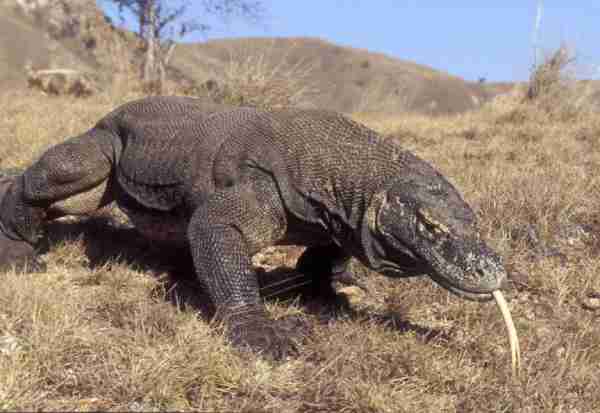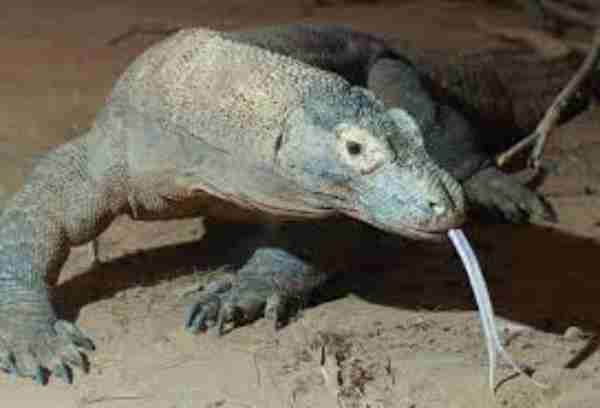The Komodo dragon may be the largest lizard alive, but don’t let their size fool you – these creatures are not harmless. Endemic to Indonesia and found on islands like Komodo, Flore, Rinca, and Gili Motang, these giants can weigh up to 200 pounds and grow up to 10 feet long. Their powerful jaws can deliver a deadly bite of 1,000 PSI, which is also venomous enough to kill a buffalo. Though they don’t actively attack people, their sheer size and lethality make it crucial to exercise caution when in their presence. These fascinating creatures may be a sight to behold, but it’s important to remember that from a safe distance.
Table of Contents
Why Are Komodo Dragons Dangerous?

Now that we have established the dangerous nature of Komodo dragons, let us delve into each aspect individually to understand why these colossal reptiles pose a significant threat.
Komodo Dragons Are Quick
Komodo dragons possess remarkable speed, surpassing that of humans. When an animal of such size exceeds human swiftness, it is undoubtedly a cause for concern.
Although Komodo dragons may not maintain their speed over long distances, if you initiate a sprint, they will easily outpace you. Despite their seemingly sluggish appearance, they can reach speeds of around 20 kilometres per hour, while the average human can only manage 10 to 13 kilometres per hour.
Furthermore, Komodo dragons are known to hunt in groups. Thus, if one lizard begins the pursuit, there is a possibility that others will join in the chase. This increases the likelihood of multiple Komodo dragons hunting you simultaneously.
Fortunately, there is a silver lining: fast-moving Komodo dragons have a limitation – they can only run in a straight line. This provides a slim opportunity for escape if you can swiftly change direction.
Komodo Dragons Are Poisonous
The fearsome reputation of the Komodo dragon has been bolstered by the little-known fact that it is a poisonous creature. Its venom has proven to be deadly, capable of taking down animals as large as buffalos or humans. The venom works by preventing blood clotting and widening blood vessels, causing the victim’s blood pressure to sharply drop.
This could result in death due to loss of blood, or the venom could induce a state of shock. Furthermore, any bite from a Komodo dragon is likely to become infected quickly, leading to further complications. Despite their formidable physical size and the fact that they can devour entire prey, it’s this venomous addition that truly makes the Komodo dragon one of the deadliest creatures on the planet.
Komodo Dragos Have Deadly Bite
Komodo dragons are truly fearsome creatures, renowned for their powerful bite and status as apex predators. These massive lizards lurk in the bushes, always on the lookout for their next meal. Once they spot their prey, they pounce with lightning speed, using their massive jaws to clamp down with bone-crushing force. The strength of their bite is truly astonishing, producing a pressure of around 1,000 PSI.
This may not be as much as a shark bite, but when you add in the brute strength of the dragons, their biting venom, and their razor-sharp teeth, you begin to see just how deadly they can be. With their light but agile head and neck, Komodo dragons rely on a combination of speed and strength to take down even the most formidable prey.

Are Komodo Dragons Aggressive?
Komodo dragons possess the capability to exhibit aggression. Being wild animals, they share this characteristic with numerous other creatures in the animal kingdom. Although Komodo dragons are not inherently inclined towards excessive aggression, certain attacks can be attributed to their predatory instincts. Frequently, interactions with humans can provoke irritation in these animals, prompting them to display aggressive behaviour driven by their innate animal instincts.
Komodo dragons have the potential to demonstrate aggression and are unlike some familiar lizards you may be accustomed to. They prefer not to be disturbed and avoid any contact with humans. Considering that the average human is similar in size to the prey of a Komodo dragon, the reptile may perceive humans as potential prey. When provoked or perceiving a threat to their own lives, they can exhibit highly aggressive behaviour.
It is important to note that Komodo dragons are not peaceful creatures and should not be considered friendly. Numerous instances have been documented where these reptiles have displayed aggression, particularly towards humans and young children.
Do Komodo Dragons Attack Humans?
While it is not a common occurrence, it is important to acknowledge that Komodo dragons have been known to attack and harm humans, with some cases resulting in fatalities. As natural hunters and predators, their primal instincts drive them to seek survival and food, viewing anything as potential prey when hungry.
As previously mentioned, a Komodo dragon can effortlessly overpower a water buffalo, and an average human is comparable in size to their typical prey. Their venomous bite enables them to swiftly dispatch large animals, and unfortunately, this includes humans as well.
Fortunately, Komodo dragons are not widespread globally and are limited to specific islands in Indonesia, such as Komodo, Flore, Rinca, and Gili Motang. Therefore, encounters with these creatures are not an everyday occurrence in most parts of the world.
However, if you ever find yourself in the vicinity of these Indonesian islands, it is crucial to be mindful that Komodo dragons can threaten humans. They are not docile creatures seeking human companionship but wild predators that perceive humans as potential prey.
Even when Komodo dragons are kept in captivity or enclosures, it is essential to remember that they are still aggressive and have been known to attack humans in such settings.
How To Survive a Komodo Dragon Attack?
To minimize the risk of a Komodo dragon attack and ensure your safety, it is important to follow these essential steps:
- Avoid Going Alone: Komodo dragons tend to target isolated prey. It is advisable to visit the park or its natural habitat with a guide or in the company of trained individuals who can provide assistance and guidance.
- Stick to Official Trails: Stay on the designated park trails and avoid venturing into unknown areas. Komodo dragons are skilled at camouflage, and straying off the designated paths increases the chances of inadvertently coming too close to these creatures.
- Maintain a Safe Distance: The most crucial aspect of preventing a Komodo dragon attack is to keep a significant distance between yourself and the lizards. Getting too close may make them feel threatened, potentially triggering an attack. Additionally, avoid making sudden movements that could provoke a defensive response.
- Utilize Zig-Zag Running: In the unfortunate event that you find yourself facing a dangerous Komodo dragon, take advantage of their limited stamina. These creatures are fast but tire quickly. Running in a zig-zag pattern may discourage the Komodo dragon from pursuing you further.
- Defend Yourself: If you are confronted directly by a Komodo dragon, it is essential to protect yourself. Avoid being bitten by targeting vulnerable areas such as the eyes, nose, and inside of the mouth. Use a long stick or throw stones to deter the animal and aim for its face.
By following these precautions and being aware of your surroundings, you can reduce the risk of a Komodo dragon attack and ensure your safety in their presence.
Do Komodo Dragons Eat People?
While it is true that Komodo dragons have been observed eating human corpses, such incidents are rare and occur only when other food sources are scarce. There is little to no reason for concern about being eaten by a Komodo dragon.
To better understand their diet, Komodo dragons are carnivorous creatures with a wide-ranging food preference. They commonly consume birds and their eggs. Young Komodo dragons feed on small animals, insects, eggs, and small reptiles, while older ones target larger reptiles and even smaller Komodo dragons. Additionally, they have been known to prey on various small mammals such as monkeys, as well as larger mammals including horses, deer, goats, and water buffalo.
On rare occasions, if given the opportunity, Komodo dragons may hunt, attack, and bite humans. If fortunate, they might even consume human flesh. It is indeed peculiar that Komodo dragons have been observed eating corpses, including those of humans. This phenomenon is not a Halloween tale but a documented occurrence.
In areas where Komodo dragons coexist with human populations, precautions have been taken to protect gravesites. People have relocated the graves of their loved ones to different locations and made them deeper. Additionally, rocks have been piled on top of graves to prevent Komodos from digging them up.
While the consumption of human corpses by Komodo dragons does happen, it is important to emphasize that these incidents are infrequent and typically associated with specific circumstances, such as limited food availability.
Final Words
Komodo dragons are truly an impressive sight to behold. These giant lizards are not only the largest lizards on the planet, but they also have a deadly poisonous bite that can kill a person in less than one hour. While there have been cases of humans being attacked by Komodo dragons, it is important to remember that they do not actively hunt people. They are wild animals and should be treated with respect and distance. By keeping yourself at a safe distance, you can greatly reduce the risk of being attacked. Despite their status as the most dangerous lizards on the planet, these creatures are fascinating to observe from afar.
Reference:
- https://nationalzoo.si.edu/animals/news/how-dangerous-are-komodo-dragons-and-other-komodo-dragon-facts
- https://www.ncbi.nlm.nih.gov/pmc/articles/PMC8702757
- https://www.nbcnews.com/id/wbna30913500

Zahra Makda
Growing up enjoying the beauty of my village, a good passion for nature developed in me from childhood. Following my passion for the natural world, I have chosen zoology for my graduation, during my undergraduate degree, I participated in many nature trails, bird watching, rescues, training for wildlife conservation, workshop, and seminars on biodiversity. I have a keen interest in invertebrate biology, herpetology, and ornithology. Primary interests include studies on taxonomy, ecology, habitat and behavior.









